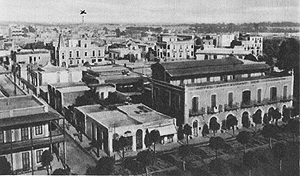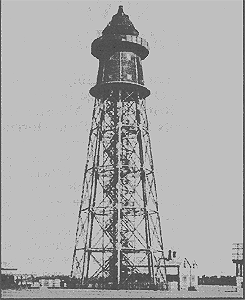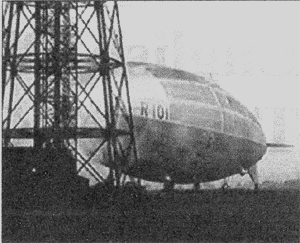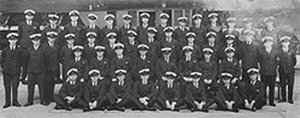
AIRSHIP BASE AT ISMAILIA
WHY IT WAS NEVER USED
The Ismailia site was chosen for its suitability of level, well drained ground and an area of some 600 acres and because of its close connections to the Suez Canal.. The location was deemed suitable in 1926 as part of the main Imperial Communications Commission visit, and a mooring mast was erected along with a hydrogen gas plant for re-supplying the airships. The Silcol Hydrogen Plant had an output of 60,000 cubic feet per hour.
The mast itself was an exact copy of the Cardington mast but with no additional building erected around the base as with the Canadian and Indian mast sites. The housing shed or hangar at Karachi is the largest building in the British Empire, being slightly larger than either of the Airship Sheds at Cardington.

This picture, looking west towards Moascar & RAF Ismailia was taken from the
tower of the Roman Catholic Church on Empress Avenue.
In the far distance on the left horizon, if one looks closely, is the Airship Mooring Tower (marked X)
intended for use by the ill-fated R101, which is just visible.
The 1930 review commented that commercial operations in Egypt would improve considerably with the creation of the Maltese mast when the current R101 and R100 would be able to carry a more commercial load (passengers and freight) if they could offset the additional weight by reducing fuel range, and depend on the intermediate Malta stop to refuel. It was agreed that the ships would operate a regular service as far as Ismailia for a commercial service, and the Atlantic and Indian “runs” would be considered more as publicity flights.
Mooring mast and refueling facilities installed at Ismailia and Karachi were never used.
No airship reached either destination. Remains of the mooring and refueling installations could still be seen at RAF Ismailia in the 1950’s.

The Mooring Tower at Ismailia - 1929
THE R101 AIRSHIP DISASTER
Shortly after dusk (7.37 pm) on Saturday, 4th October, 1930, the largest airship made in Britain took off on her much-publicized maiden flight. The R101 (the R stood for Rigid) slipped from her mooring-mast at Cardington airfield, Bedfordshire, in heavy, blinding rain. She was bound for France, Egypt (Ismailia), and then India, before returning home. The round trip of 8,000 miles was scheduled for completion in 15 days. The R101 was due to arrive at Ismailia on Monday, 6th October with a stop of about 12 hours for refueling.
The R101 was the pride of the Ministry of Aviation, and of Britain’s second Labour government. She was hailed as an all-round improvement over her privately-owned rival the R100, and the Secretary of State for Air, Lord Thomson, was the most prominent public figure among the six passengers, who included his personal valet, James Black. Sir Afton Brancker, Director of Civil Aviation, Wing Cmdr R.B. Colmore, Director of airship development, Lieut Col Richmond and Maj G.H. Scott, designer of the R-34 were also on board.

The R101, the largest airship in the world and the latest bidder for aerial honours,
soared away from her mooring base at Cardington on her maiden flight –
a scheduled two week return flight to India, via Ismailia
Officially, all was optimism as the giant, silver airship slowly made her way towards the south coast. Lord Thomson and his fellow guests, all of them leaders of aviation, enjoyed an excellent dinner, followed by brandy and cigars. Unofficially, however, the flight was overclouded by fears that the venture would end in defeat, if not disaster. Even Lord Thomson was not without anxieties and doubts. The day before the maiden flight, the Air Minister made out his will and took out extra life insurance. None of this was revealed to the public at the time, and Lord Thomson confidently told newspapermen: “The R101 is as safe as a house – except for the millionth chance.”
On paper, this should have been so. The R101 was 230 metres long and was powered by five huge diesel engines. Special steering equipment had been installed to move the rudders, and highly inflammable hydrogen was stored in her vast gas bags, more then enough to lift the dirigible and 60 tons of valuable cargo high into the air. Even so, there was a snag, and a very serious one at that. Apart from the fact that, unlike the much more expensive helium, hydrogen was highly explosive, the airship was simply too heavy. Despite all the gas she carried, the R101 had not flown well in tests, and the engineer and novelist, Neville Shute, one of the brains behind the rival R100, later wrote: “An airship is safe in proportion to its useful lift, in proportion to the weights that it can jettison in an emergency, and by that standard R101 was definitely dangerous. In our view, also, she was considerably underpowered.”
Privately, Lord Thomson also felt that the R101 was not yet ready for the round-trip but in public he pretended that all was well, for the prestige of the British aviation industry depended upon the success of the flight, and air experts throughout the world were keenly awaiting the outcome.
In fact, the airship ran into trouble while still over England. One of her engines unaccountably stopped and, by the time the fault had been found and corrected, she was cruising at 62 km/hr over Northern France where the torrential rain persisted, and strong winds whipped against the fabric.
But there was no need to panic, and the wireless operator tapped out a message to the Royal Airship Works at Cardington stating: “All well … course now set for Paris. Intend to proceed via Paris, Tours, Toulouse and Narbonne.”
Gradually, however, the great dirigible began losing height in the bad weather. Soon after midnight, when Lord Thomson and his fellow guests were comfortably asleep in their beds, and engineer looked out of the window of his cabin and gave a shout of alarm. “We’re at roof level!” he cried. “I saw a church?” He had just seen the spire of Beauvais Cathedral, some 80 km north-west of Paris. No sooner had he spoken, than the ship dipped and lurched level again. The engine telegraph ran urgently for “Slow”. But the airship dipped a second time, and a low hillside loomed ahead through the teeming rain.
Slowly, reluctantly almost, the streamlined nose of the R101 stubbed itself into the grass. The airship began to crumple like an enormous silver toy. Its finely stressed girders snapped and buckled, ripping the gasbags to shreds. The hydrogen poured out and, as it did so, there came the worst mishap of all. A severed electrical cable cracked and sparked. Within seconds the ship was engulfed in red and yellow flames. A huge fireball shot high into the sky. The R101’s girders glowed white hot as Lord Thomson, all the other passengers and most of the crew were burned to death. Of the 54 people who had set out from Cardington some six hours earlier, only six crew members survived and were badly burned and maimed. (Two of which later died of their injuries)
As dawn broke, the charred wreckage of the once-proud dirigible lay on the hillside like the bones of some prehistoric monster. The millionth chance had happened, and it was the end not only of the R101, but of the manufacture and use of airships in Britain. Having already made nine arduous flights, including several to Canada and back, the R100 was dismantled and sold for scrap.
Next came a series of official, and unofficial, enquiries into the disaster. According to Neville Shute, Lord Thomson – tipped as the next Viceroy of India – had wanted to “arrive from the skies in a manner unknown to any previous viceroy”. According to Sir John Simon, who headed the official enquiry and who agreed with Shute, there had been a gasbag failure which had caused the R101 so tragically to lose height and then crash.
French Air Ministry officials ascribed the disaster to high wind. They said
the R101 hurtled downward into the field, burst into flames and exploded. Since
early evening the wind had been rising over the French channel coast, heralding
a storm out in the Atlantic. It struck heavily soon after midnight

The crew of the ill-fated R101 (with special white topped caps)
The following Wednesday (8th October 1930), the bodies of those whose had perished were brought back to the UK by train to lie in state in Westminster Hall. Tens of thousands of mourners filed past. On Friday, a service was held at St. Paul’s Cathedral. King George V was represented by the Prince of Wales.
On Saturday, 11th October 1930, the funerals took place at Cardington. All were buried at St. Mary’s Church, Cardington where a prominent memorial commemorates them.